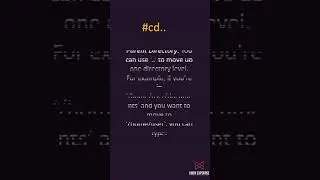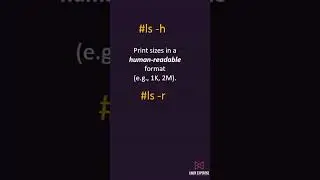LINUX BASIC COMMAND | LINUX_EXPERTISE | LINUX COMMAND |
#LINUX BASIC COMMAND | #LINUX_EXPERTISE | LINUX COMMAND
Learn Linux Like Pro | Linux Basics ls Commands | Linux Commands
Linux Basic Commands | Linux Command
Linux is a computer operating system free for development and distribution, both commercially and non-commercially. There are times when you may spend hours doing a repetitive task. A person who knows command line can write a script in 10 minutes and if he has to repeat it, can do it in a second. So what is Command Line and why is it so popular? Command line applications provide us with numerous benefits which cannot be achieved with any of the available GUI applications. One can create scripts to automate work, and can go so much deeper into the system and explore things that would generally be not possible with GUI.
Linux bash shell programming tutorials. Learn the Linux/ Unix command line (Bash) with beginners tutorial. Clear descriptions, command outlines, examples, shortcuts and best practice. Learn the Command Line. Linux Terminal Tutorial. Linux Command Line Basics. Searches related to Linux command line tutorial for beginners. Linux command line tutorial .learn Linux command line. Linux command line basics. Linux command line prompt. Linux command line cheat sheet. Linux command with example
basic Linux command. Linux tutorial for beginners.
Here are some basic Linux commands along with their short descriptions :
The `cd` command is used to change the current working directory in a Unix/Linux operating system. Its basic syntax is:
cd [directory]
Here, `[directory]` is the path to the directory you want to change to. Some common variations and uses include:
1. Moving to a Specific Directory: You can specify the path to the directory you want to move to. For example:
#cd_/path/to/directory
2. Moving to the Home Directory: If you type `cd` without specifying a directory, it will take you to your home directory. For example:
#cd
3. Moving to the Previous Directory: You can use `cd -` to go back to the previous directory you were in.
4. Relative Paths: You can use relative paths to move to directories relative to your current location. For example, if you're in `/home/user` and you want to move to a directory called `documents` within that directory, you can simply type:
#cd documents
5. Parent Directory: You can use `..` to move up one directory level. For example, if you're in `/home/user/documents` and you want to move to `/home/user`, you can type:
#cd ..
6. Multiple Directories: You can use `cd` with multiple directory arguments separated by spaces. This will move sequentially through each directory. For example:
#cd dir1 dir2 dir3
Remember that paths can be absolute (starting from the root directory `/`) or relative (starting from the current directory). If a directory name contains spaces or special characters, you might need to enclose it in quotes.
The `cd` command is one of the fundamental commands in the Unix/Linux command line interface, and it's used extensively for navigating the file system.



![[ Hazbin Hotel Song ] IL PADRE MIGLIORE DELL'INFERNO (Animation) - Lucyfer version with](https://images.mixrolikus.cc/video/_ADtW_GIUQA)











